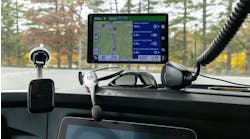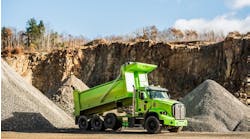A few years ago, it was nearly impossible to avoid blockchain hype within the freight transportation industry. Its potential was touted by keynote speakers and during seminars at countless industry events in 2017 and 2018. But like many next-big things, the hype waned without much to show for it in trucking. That could be changing as the importance of digitized supply chains are magnified by the ongoing COVID-19 pandemic.
“It’s like we talked about it too much, and everyone started rolling their eyes,” John Monarch, CEO of ShipChain, told FleetOwner. While many fleet executives might have been doubting the hype, blockchain companies like his “were nose-down, building it out."
"And now we’re to the point where things are really picking up again, especially for enterprise and supply chain,” Monarch said.
Since the COVID-19 pandemic upended retail supply chains this year, blockchain is re-emerging as a solution for an industry looking to find better ways to meet the increasing demands of e-commerce last-mile fulfillment.
As the coronavirus pandemic continues, consumers are looking for more flexible shopping options — from same-day home delivery to curbside pickup — that limit human contact. Fleets being pressured to provide the goods to make these contactless deliveries possible should not expect the demand to slow any time soon.
The COVID consumer is expected to stick around after the pandemic, relying more on online shopping than in the past. Nearly seven in 10 consumers believe the shift to digital payments will be permanent, and almost half plan to use more cashless payments even after the pandemic, according to a global study by Mastercard this spring. In the U.S., e-commerce spending jumped 93% year over year this May, the study found. That will continue to put pressure on carriers to streamline deliveries and supply chains.
“While no one could have predicted the state of the world we’re in today, it has reinforced the necessity for us to continue evolving the consumer payment experience to meet the consumer wherever they are,” said Jorn Lambert, executive vice president of digital solutions for Mastercard. “We’ve been focused on building our digital-first capabilities for years, which have enabled this accelerated shift to digital payments. It’s unlikely consumers will revert to old payment habits.”
New opportunities
The COVID consumer is creating opportunities for location data and technology companies such as HERE Technologies. “We’re actively looking into blockchain technology for a multitude of use cases,” said Edzard Overbeek, HERE CEO. “One of the more exciting ones is to architecturally think through where new geospatial databases need to go.”
A blockchain is a fixed trustless registry of entries, hosted on an open distributed network of nodes. It is called “trustless” because it doesn’t require a trusted intermediary. This makes systems that rely on blockchain technology potentially safer and less expensive than traditional centralized databases and resilient to attacks. The technology also enhances transparency and accountability and keeps companies in control of their own data.
Overbeek said that blockchain would help HERE create better routing and faster onboard computing in vehicles by relying on ultrafast 5G networks’ cloud databases that could help supply chains and autonomous vehicles that will need near-minimum latency. “Blockchain will help us build that kind of architecture,” he explained, “but it does something else. It makes sure that all these digital ledgers and all these different compute cycles are mirrored toward each other so that you have one single layer that is always the true layer — if we call it that — where the state of the data is.”
Because blockchain data is continuously synced across a shared ledger, all parties involved in the supply chain can record and view all the transactions as freight from its origin to its destination, according to Dan Clark, founder and president of Kuebix.
Kuebix, a transportation management system (TMS) and creator of a broad connected shipping community, was acquired by Trimble earlier this year so the two entities could devise the largest network of shippers and carriers in the North American supply chain. Shippers, carriers, and intermediaries are currently operating on fragmented TMS software. But Trimble is working to create a “single, connected supply chain” where all stakeholders work off the same technology.
“The dependency of that single network has kind of been the challenge for blockchain,” Clark told FleetOwner. “It’s an exciting technology when you start looking at what’s going on in the world with COVID and really being able to understand the tracking of goods or commodities from the source right through delivery. To be able to track every event that happens, knowing that every event is accurate and real because of the blockchain, is a powerful, positive thing.”
Keeping America stocked
Blockchain could have even saved much of America from the toilet paper shortages that ravaged the nation this spring when pandemic fears spread, and some consumers started hoarding supplies.
“If we had a blockchain at the beginning of the year, we’d have had visibility to the inventory on the supply chain of toilet paper,” Vasanth Srinivasan, vice president of enterprise architecture and strategy at Trimble, told FleetOwner.
With blockchain, paper manufacturers, shippers, carriers, distributors, and retailers would have had easier access to where toilet paper supplies were plentiful and where they were sparse across the supply chain, Srinivasan explained. Instead, the essential supply shortage of early 2020 showed that supply chains in North America were not balanced.
“In order to build a very good supply chain, you have to have access to all the key information,” he said. “Regardless of who manufacturers it and regardless of who hauls it, with all this information in the blockchain, you can solve supply problems.”
The potential for transforming supply chains is astounding, Clark added. “When blockchain first came out, the buzz behind it was incredible,” he said, “but that kind of subsided a bit until COVID. Based on the events that happened in the world, there’s more and more of a need for technology such as blockchain for many different reasons — whether it’s the COVID-type of pandemic right to Homeland Security. It’s just still in its infancy stages, but it’s something that I believe will be a major part of our supply chain future.”
Creating visibility
After supply chain kinks threatened grocery and pharmaceutical freight early in the pandemic, shippers in those industries are starting to turn to blockchain, ShipChain’s Monarch noted. As winter approaches with dropping temperatures and COVID-19 showing few signs of slowing down, he expects blockchain to become more critical.
“ShipChain was founded on the idea of ‘Why is it you can see where your pizza delivery is in transit—with dots on a map on your phone—but not your multimillion-dollar shipment of freight?’” Monarch explained, noting ShipChain’s goal is to create more trusted visibility in the freight world.
Monarch advised successful supply chain managers are prioritizing robotics, Internet of Things (IoT) sensors, blockchain, and other digital solutions that offer visibility and flexibility. That digitization of the supply chain makes it more resilient, particularly during catastrophic events such as a global pandemic. Additionally, digitized supply chains have several benefits for the entire organization, like increased efficiency, profitability, and resilience in the face of adversity.
For fleets that have stayed on the blockchain sidelines but are looking to make the technology part of their business, Monarch advised them not to be overwhelmed by the complicated nature of blockchain.
“If you’re not doing software development in-house, find another company that’s focusing on it,” he suggested. “Don’t try to build your own development team just for the sake of it. Unless you’re a software developer, you should never have to see a blockchain until you need it for a dispute. And that’s the way we want to keep it. It should just operate in the background like the internet.”





